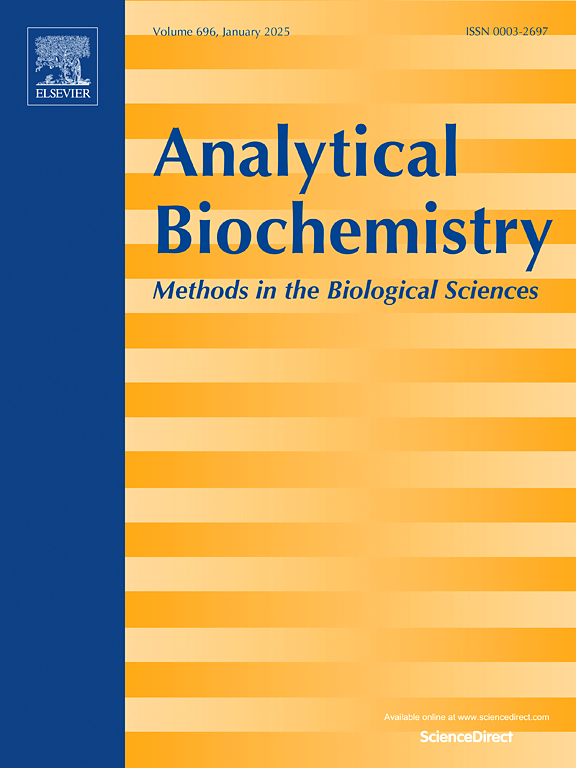Enhancing lateral flow assay performance: Buffer additives and protein-membrane interactions
IF 2.5
4区 生物学
Q2 BIOCHEMICAL RESEARCH METHODS
引用次数: 0
Abstract
Lateral Flow Assays (LFA) have been valuable tools for point-of-care diagnostics for decades. During periods of high testing demand, as recently in the Covid-19-pandemic, it is necessary to deepen the understanding of test and control line signal intensities. This study investigates the interaction between proteins and structurally different nitrocellulose (CN) membranes and the resulting effects on signal intensity in an LFA under the influence of various buffer additives. The experiments focused on quantitative protein adsorption, protein stability, protein line printing and changes in signal intensity in a human chorionic gonadotropin (hCG)-assay. A method was established for detecting the widths and intensities of fluorescent protein lines. We were able to show that changes in signal intensity of LFAs are driven by accessibility of the antibodies, by hydrophilicity of the membrane or assisted adsorption of antibodies onto the membrane. Additionally, the inclusion of sodium chloride, polysorbate 80 and sodium dodecylbenzenesulfonate can enhance signal intensity. The method developed for protein line analysis has proven to be effective and can help to understand protein-membrane-interactions on a macroscopic level. We demonstrate that LFA-manufacturers have a range of options to fine-tune assay performance without major modifications to assay components.

增强横向流动分析性能:缓冲剂添加剂和蛋白质膜相互作用
几十年来,横向流动测定法(LFA)一直是即时诊断的宝贵工具。在测试需求高的时期,如最近的covid -19大流行期间,有必要加深对测试和控制线信号强度的理解。本研究研究了在不同缓冲添加剂的影响下,蛋白质与结构不同的硝化纤维素(CN)膜之间的相互作用及其对LFA中信号强度的影响。实验重点研究了人绒毛膜促性腺激素(hCG)测定中蛋白的定量吸附、蛋白稳定性、蛋白线打印和信号强度的变化。建立了一种检测荧光蛋白线宽度和强度的方法。我们能够证明LFAs信号强度的变化是由抗体的可及性、膜的亲水性或抗体在膜上的辅助吸附所驱动的。此外,氯化钠、聚山梨酯80和十二烷基苯磺酸钠的包合可以增强信号强度。该方法用于蛋白质系分析已被证明是有效的,可以帮助在宏观水平上理解蛋白质-膜的相互作用。我们证明lfa制造商有一系列的选择来微调分析性能,而不需要对分析成分进行重大修改。
本文章由计算机程序翻译,如有差异,请以英文原文为准。
求助全文
约1分钟内获得全文
求助全文
来源期刊

Analytical biochemistry
生物-分析化学
CiteScore
5.70
自引率
0.00%
发文量
283
审稿时长
44 days
期刊介绍:
The journal''s title Analytical Biochemistry: Methods in the Biological Sciences declares its broad scope: methods for the basic biological sciences that include biochemistry, molecular genetics, cell biology, proteomics, immunology, bioinformatics and wherever the frontiers of research take the field.
The emphasis is on methods from the strictly analytical to the more preparative that would include novel approaches to protein purification as well as improvements in cell and organ culture. The actual techniques are equally inclusive ranging from aptamers to zymology.
The journal has been particularly active in:
-Analytical techniques for biological molecules-
Aptamer selection and utilization-
Biosensors-
Chromatography-
Cloning, sequencing and mutagenesis-
Electrochemical methods-
Electrophoresis-
Enzyme characterization methods-
Immunological approaches-
Mass spectrometry of proteins and nucleic acids-
Metabolomics-
Nano level techniques-
Optical spectroscopy in all its forms.
The journal is reluctant to include most drug and strictly clinical studies as there are more suitable publication platforms for these types of papers.
 求助内容:
求助内容: 应助结果提醒方式:
应助结果提醒方式:


